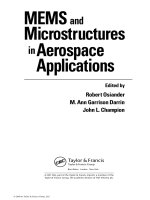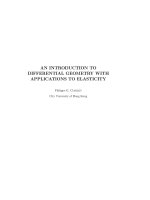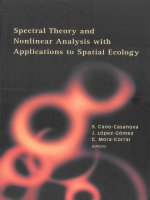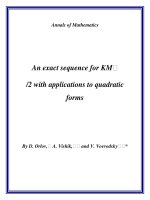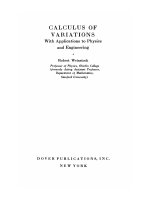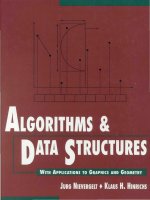Spectral Theory and Nonlinear Analysis with Applications to Spatial Ecology pot
Bạn đang xem bản rút gọn của tài liệu. Xem và tải ngay bản đầy đủ của tài liệu tại đây (10.44 MB, 288 trang )
Spectral Theory and
Nonlinear Analysis with
Applications to Spatial Ecology
This page intentionally left blankThis page intentionally left blank
Spectral Theory and
Nonlinear
Applications
to
Spatial Ecology
Universidad Complutense de Madrid, Spain
14-15
June
2004
S.
Cano-Casanova
Universidad Pontificia Comillas de Madrid, Spain
J.
Lopez-Gomez
Universidad complutense de Madrid, Spain
C.
Nlora-Corral
university of Oxford,
UK
editors
K
World
Scientific
NEW JERSEY
*
LONDON
*
SINGAPORE BElJlNG SHANGHAI
*
HONG KONG
-
TAIPEI
*
CHENNAI
Analysis with
Published by
World Scientific Publishing
Co.
Re. Ltd.
5 Toh Tuck Link, Singapore 596224
USA
office:
27 Warren
Street,
Suite
401-402,
Hackensack,
NJ
07601
UK
office:
57 Shelton Street, Covent Garden, London WC2H 9HE
British
Library Cataloguing-in-Publication Data
A
catalogue record
for
this
book is available
from
the British Library
SPECTRAL THEORY AND NONLINEAR ANALYSIS WITH APPLICATIONS
TO SPATIAL ECOLOGY
Copyright
0
2005 by World Scientific Publishing Co. Re. Ltd.
All
rights reserved. This book, or parts thereof; may not be reproduced in any form or by any means,
electronic or mechanical, includingphotocopying, recording or any information storage and retrieval
system now known or to be invented, without written permission from the Publisher.
For
photocopying of material in this volume, please pay a copying fee through the Copyright
Clearance Center, Inc., 222 Rosewood Drive, Danvers,
MA
01923,
USA.
In this case permission
to
photocopy
is
not required from the publisher.
ISBN 981-256-514-0
Printed in Singapore by Mainland Press
Preface
This volume collects the Proceedings of the Complutense International
Seminar
Spectral
Theory
and Nonlinear Analysis
that we celebrated in
Madrid in June 14th and 15th, 2004, at the Department of Applied Math-
ematics, under the auspices of the Spanish Ministry of Education and Sci-
ence, under Grant REN2003-00707, and Complutense University through
an International Seminar budget, which allowed
us
to invite some
of
the
most renowned experts in these fields. Besides the editors, the following
experts participated in the International Seminar:
F.
Cobos (Madrid), E.
N. Dancer (Sydney), I. Gohberg (Tel Aviv), D. MacGhee (Glasgow), R.
J.
Magnus (Reykjavik),
J.
Mawhin (Louvain La Neuve), A. G. Ramm (Man-
hattan, Kansas), B.
P.
Rynne (Edinburgh), and A. SuArez (Sevilla), among
many others that attended some of the talks delivered in that International
Seminar, whose kind assistance certainly facilitated its success.
Such International Seminar
was
organized to honor the memory of
our
friend and colleague
J.
Esquinas, born
in
March 27th 1960 at Ocaiia
(Toledo, Spain), who suddenly died in August 11th 2003 at Covadonga
National Park (Asturias, Spain). J. Esquinas was a tremendously gifted
mathematician who did some seminal contributions to the theory of gen-
eralized algebraic multiplicites in the context of bifurcation theory. His
scientific carrier was
as
short
as
intense, since he dedicated many of his
efforts to the defense of the rights of the workers in Spanish Universities,
becoming a renowned very popular personality in both issues.
Besides collecting most of the contributions delivered by the participants
in this Complutense International Seminar
,
this volume also includes a
number
of
contributions by well recognized experts in Spectral Theory,
Differential Equations and Nonlinear Analysis whose mathematical work
is closely related to the one developed by
J.
Esquinas. The editors are
delighted to thank all of them for their contributions to this
so
special
honoring volume.
July 2005
The editors
V
This page intentionally left blankThis page intentionally left blank
Poster of the Seminar
This page intentionally left blankThis page intentionally left blank
Contents
Preface
v
Poster of the Seminar
vii
On the Positive Solutions of the Logistic Weighted Elliptic BVP
with Sublinear Mixed Boundary Conditions
S.
Cano-Casanova
1
Logarithmic Interpolation Spaces
F.
Cobos
17
Remarks on Large Solutions
J. Garcia-Melicin and
J.
Sabina de Lis
31
Well Posedness and Asymptotic Behaviour of a Closed Loop
Thermosyphon
A.
Jimknez-Casas
59
Uniqueness of Large Solutions for
a
Class of Radially Symmetric
Elliptic Equations
J. Ldpez-Gdmez
75
Cooperation and Competition, Strategic Alliances, and the
Cambrian Explosion
J.
Ldpez-Gdmez and
M.
Molina-Meyer
111
Local Smith Form and Equivalence for One-parameter Families
of
F'redholm Operators of Index Zero
J. Lbpez-Gdmez and
C.
Mora-Corral
127
Multilump Solutions
of
the Non-linear Schrodinger Equation
-
A Scaling Approach
R.
J.
Magnus
163
Some Elliptic Problems with Nonlinear Boundary Conditions
C.
Morales-Rodrigo and
A.
Sua'rez
175
ix
X
Contents
Dynamical Systems Method (DSM) and Nonlinear Problems
A.
G.
Ramm
201
B.
P.
Rynne
229
L.
Vega
247
J.
M.
Vegas
257
Some Recent Results on Periodic, Jumping Nonlinearity Problems
Some Remarks about the Cubic Schrodinger Equation on the Line
Some Remarks on the Invariance
of
Level Sets in Dynamical Systems
ON THE POSITIVE SOLUTIONS
OF
THE LOGISTIC
WEIGHTED ELLIPTIC BVP WITH SUBLINEAR
MIXED BOUNDARY CONDITIONS*
S.
CANO-CASANOVA
Departamento de Matemdtica Aplicada
y
Computacidn
Escuela Te'cnica Superior de Ingenieria
Uniuersidad Pontificia Comillas de Madrid,
2801
5-Madrid, SPA IN
E-mail:
This paper is dedicated, with
my
greatest admiration, to the great
mathematician, colleague and fiend J. Esquinas Candenas. He,
joint with Professor
J.
Ldpez Gdmez are the main responsible
of
my
scientific formation
In this work we prove the uniqueness of positive solution and characterize the
existence of positive solutions of
a
wide class of elliptic
BVP
of Logistic type with
sublinear weighted mixed boundary conditions. The results obtained in this work
are an extension of the previous one found in
S.
Cano-Casanovag. Monotonicity
techniques are the main technical tools, used to develop the mathematical analysis.
1.
Introduction
The main goal of this paper is
to
prove the uniqueness
of
positive solu-
tion and to characterize the existence
of
positive solutions of the following
nonlinear weighted elliptic boundary value problem of Logistic type, with
sublinear weighted mixed boundary conditions given by
15
=
XW(z)u
-
a(z)uT
&u
=
V(z)u
-
b(z)uq
=
0
on
rl,
q
>
1,
in
R,
T
>
1,
{
u=O
on
ro,
(1)
*This work has been partially supported by the Spanish Ministry of Science and Tech-
nology under Grant REN2003-00707.
1
2
S.
Cano-Casanova
where by
a
positive solution
of Problem
(1)~
we mean any function
u
:
fi
-+
[0,
GO)
such that
u
E
Wz(R),
p
>
N,
u
>
0
and satisfies Problem
(1)
a.e.
in
R
for the value
X
of the parameter. The results obtained in this work
are an extension of the previous one, obtained by
S.
Cano-Casanovag for
Problem
(1)
in the particular case when
W
=
1
in
R
and
V
=
0
on
rl.
Throughout this work we make the following assumptions:
(a)
The domain
R
is
a
bounded domain of
RN,
N
2
1,
of class
C2,
whose
boundary
dR
=
ro
U
rl,
where
FO
and
l?l
are two disjoint open and closed
subset of
do.
(b)
X
E
R
and
C
stands for a linear second order differential operator of
the form
which is uniformly strongly elliptic in
52
with
ayij
=
aji
E
C'(fi),
ai
E
C(fi),
a0
E
&(a),
1
5
i,j
5
N.
(c)
The potential
a(.)
E
L,(R)
is
a
nonnegative bounded measurable
real weight function in
R
for which there exists an open subset
R:
of
R
with
a finite number of components of class
C2
with disjoint clousures, satisfying
dist(I'1,
a@
n
R)
>
0,
such that
a
=
0
in
52;
and it is bounded away from
zero on any compact subset of
[R
\
fi:]
U
[I'l
\
dR:].
(d)
The potential
W(x)
is
a
bounded measurable real weight function
in
$2
with arbitrary sign.
(e)
As
far
as
the nonlinear mixed boundary conditions,
b(x)
E
C(rl)
is
a
positive function on
I'l
which is bounded away from zero on
I'l
n
do:,
V(x)
E
C(F1)
with arbitrary sign in
rl,
u
:=
(~1,.
. .
,
vN)
E
cl(rl;RN)
being the
conormal
field
on
rl
n
a@,
i.e.,
N
j=1
on
I?l
nail:,
where
n
=
(nl
,
.
,
nN)
is the outward unit normal and finally,
a,u
:=
(VU,
u)
.
Throughout this work, for each
X
E
R,
we will denote by
C(X)
the differen-
tial operator
C(X)
:=
C
-
XW(x)
,
Positive Solutions
of
the Logistic Weighted Elliptic
BVP
3
which is uniformly strongly elliptic in
R
with the same ellipticity constant
as
the operator
L.
The following theorem collects the main results of this work.
Theorem
1.1.
Problem
(1)~
possesses a positive solution,
if
and only
if
where
.?[C(X),
B(-V(~))]
and
0:'
[,c(x>,
731
stand
for
the principal
eigen-
value
in
0
and
s2:,
respectively,
of
L(A),
subject to the boundary operators
B(-V(z))
and
D,
respectively, being
Moreover,
in
this case, the positive solution
of
Problem
(1)~
is unique and
if
we denote
it
by
ux,
then
ux
is strongly positive
in
R
in
the sense that
.A(.)
>
0
for each
~t:
E
s2
U
rl
and
@ux(z)
<
0
for
each
/3
E
C1(l?o;
RN).
Furthemore,
E
ro
and any outward pointing nowhere tangent vector field
ux
n
W;W.
(4)
P>
1
In particular,
ux
E
C1+a(f=l)
for all
0
<
a
<
1
and
in
addition,
ux
is a.e.
in
52
twice continuously differentiable.
2.
Preliminaries, Definitions and Main Notations
In the sequel a function
u
E
Wi(R)
is said to be
strongly positive
in
R
if
u(z)
>
0
for
each
z
E
R
Url
and
apu(z)
<
0
for
each
z
E
I'o
with
u(z)
=
0
and any outward pointing nowhere tangent vector field
/3
E
Cl(I'0;
RN).
We now introduce
a
linear boundary operator, which will play a crucial
role throughout this work. Under the assumptions of Sec.
1,
given
k(z)
E
C(rl)
we will denote by
B(k(z))
the linear boundary operator
B
:
w;(R)
-
w,2-+ro)
x
wi-+rl)
defined by
4
S.
Cano-Casanova
where
v
:=
(~1,.
. .
,VN)
E
C1(I'l;RN)
is any outward pointing nowhere
tangent vector field to
I'l.
We want to point out that using the boundary
operator
B(k(z))
just defined, Problem (1)~ can be written in the form
{
B(-V(z)
+
b(~)uP-~)u
=
0
on
dR
(6)
(L(X)
+
a(z)uT-l)u
=
o
in
R
Now we are going to introduce some basic results concerning the op-
erator
B(k(z)),
that we need to develop
our
work. Let
us
consider the
eigenvalue boundary value problem
(7)
Cp=Xp
in0
{
B(k(z))p
=
0
on
aR
It
is known, thanks to the results found in Theorem 12.1
of
H.
Amann3,
that there exists
a
least real eigenvalue of Problem
(7),
denoted in the
sequel by
@[L,
B(k(z))],
and called
principal eigenvalue
of
(L,
B(k(s)),
0).
The principal eigenvalue is simple and associated with it there is
a
positive
eigenfunction, unique up to multiplicative constants and called
principal
eigenfunction
of
(L,
B(k(z)),
0).
Thanks to Theorem 12.1 of Amann3, the
principal eigenfuntion of
(L,
B(k(z)),
R)
belongs to
Wi(R)
for
any
p
>
1
and
it
is strongly positive in
a.
In fact,
cF[L,
B(k(z))]
is the only eigenvalue
of Problem
(7)
possessing
a
positive eigenfunction, and it is dominant in
the sense that any other eigenvalue
(T
of Problem
(7)
satisfies
Re(c)
>
dw,
B(k(.))l
In the sequel, given any proper subdomain
Ro
of
R
of class
C2
with
dist
(rl,
dRonR)
>
0,
we will denote by
B(k(z),
no)
the boundary operator
build up from
B(k(z))
by
and by
I$"
[C,
B(k(z),
Ro)],
the principal eigenvalue of
(C,
B(k(z),
Ro),
00).
To
develop the mathematical analysis
of
the next sections, are essen-
tial the different monotonicity properties of
op[C,
B(k(z))]
joint with the
continuous dependence of it with respect to perturbations
of
the domain
and with respect to perturbations
of
the potential
k(z)
on the boundary,
recently proved by
S.
Cano-Casanova and
J.
L6pez-G6mez6q5.
Suppose
p
>
N.
Then, any function u
E
Wi(R)
is said to be
a
superso-
Zution (subsolution)
of Problem
(l)~,
if it satisfies
(L(X)u
+
u(z)uT,B(-V(z)
+
b(z)u"-1>u)
2
0
(I
0)
Positive Solutions
of
the Logistic Weighted Elliptic BVP
5
and it will be said that it is
a
strict supersolution (subsolution), if the
respective inequality is strict, where
2
stands for the natural product order
on
Lp(R)
x
L,(aR).
3.
On the Uniqueness and Regularity of Positive Solutions
of Problem
(1)~
In this section we prove the uniqueness of positive solution of Problem
(l)~,
if there exists, and we obtain some regularity properties about it.
Theorem
3.1.
If
ux
is a positive solution
of
Problem
(l)~,
then
.F[L(X)
+
a(z)u;-l,
B(-V(z)
+
b(z)u;-')]
=
0,
(8)
ux
is strongly positive
in
R,
(4)
is satisfied and
in
particular,
u~
E
C'+"(fi)
for all
0
<
Q
<
1.
Moreover,
ux
is a.e.
in
R
twice continuously differen-
tiable.
Proof.
Let
u~
be
a
positive solution of Problem
(1)~.
Then,
u~
E
Wz(R)
for some
p
>
N,
satisfies Eq.
(6)
and thanks to the embedding
W,2(R)
LfC2-N
*
(Q)
-
(9)
for
p
>
N,
u~
E
C2-F(fi).
Hence,
-XW(X)
+
U(Z)U';-'
E
L,(R),
+
qz)u;-'
E
c(rl),
since
a(z),
W(z)
E
L,(R)
and
UX,
b(z),
V(z)
E
C(rl), and therefore, Prob-
lem
(6)~
is well defined in the sense of Problem
(7)
and Eq.
(5).
Now, since
u~
is
a
positive solution of Problem
(6)~,
we have that
0
is an eigenvalue of
Problem
(6)~
and
u~
is
a
positive eigenfunction of Problem
(6)~
associated
with the
0
eigenvalue. Then, by the uniqueness of the
principal eigenpair,
u~
is the principal eigenfunction of Problem
(6)~
and Eq.
(8)
is satisfied.
Finally, owing to the structure and regularity of the principal eigenfunction
guaranteed by Theorem
12.1
of
H.
Amann3, we have that
ux
is strongly
positive in
R
and Eq.
(4)
is satisfied. The remaining assertions follow again
from the embedding Eq.
(9)
and Theorem
VIII.l
of E.M. Stein".
This
completes the proof of the result.
Thanks to the previous result, if we set
and we denote by
U+
the cone of non-negative functions of
U
and by
F:
RXU+
-
v,
0"
:
u+
-
w,
6
S.
Cano-Casanova
the nonlinear operators defined by
3(A,
u)
:=
L(A)u
+
a(x)uT,
(A,
u)
E
IW
x
ZA+
,
and
Gv(u)
:=
(u,
a,u
-
V(x)u
+
b(x)uq
=
B(-V(x)
+
b(x)u"-1)u),
21
E
u+
,
we have that the positive solutions of Problem
(l)~,
are the solutions cou-
ples
(X,ux)
with
ux
>
0
in
R
satisfying the system
F(A,ux)
=
0
in
R
{
Gv(ux)
=
0
on
dR.
On the other hand,
D,Gv(ux)
can be written in terms of the boundary
opertor
B(lc(x))
defined in
Eq.
(5),
by
D,Gv(ux)u
:=
B(-V(x)
+
qb(x)u;-l)u.
Theorem
3.2.
For
each
X
E
R,
the positive solution
of
Problem
(l)~,
if
there exists, is unique and non-degenerate,
in
the sense that
.T[a3-(A,ux),
~uGv(ux)l
>
0;
i.e., the linearization
of
Problem
(1)~
at any positive solution only possesses
the
null
solution.
Proof.
We argue by contradiction. Suppose
ui,
i
=
1,2
are two positive
solutions of Problem
(l)~,
such that u1
#
212.
Then, thanks to
Eq.
(S),
O~[L(A)
+
a(z)u~-l,
~(-v(x)
+
b(x)uf-l)]
=
0,
i
=
1,2,
(10)
and the following problem is satisfied
(L(4
+
a(z)F(x))(.u1
-
U2)
=
0
in
R
741
-
u2
=
0
on
I?,,
(11)
{
(av
-
V(x)
+
b(z)G(z))(u~
-
u2)
=
0
on
rl,
where
F(x)
E
C(R)
and
G(x)
E
C(l?l)
are the functions defined by
and
Positive Solutions
of
the Logistic Weighted Elliptic BVP
7
By construction,
F(.)
2
TuY-'
>
u;-',
G(-)
2
qu;-l
>
.;-I.
(1'4
Now, using the boundary operator
B(k(z))
defined by
Eq.
(5), Problem
(11)~
can be written in the form
{
B(-V(z)
+
b(z)G(z))(ul
-
ua)
=
0
on
dR.
Thanks to the monotonicity
of
the principal eigenvalue with respect to the
potential (cf. Proposition
3.3
of
S.
Cano-Casanova and
J.
L6pez-G6mez5)
and with respect to the weight on the boundary (cf. Proposition 3.5 of
S.
Cano-Casanova and
J.
L6pez-G6mez5), owing to
Eq.
(12),
and taking into
account
Eq.
(lo),
it follows that
(13)
(L(X)
+
a(z)F(z))(u1
-
~2)
=
0
in
R
.T[.c(W
+
a(z)F(z),
B(-V(z)
+
b(z)G(z))l
>
>
CTf[L(X)
+
a(z)u;-l,
B(-V(z)
+
b(z)u;-l)]
=
0.
Then, Problem
(13)~
is invertible and hence
u1
=
u2,
which gives the
contradiction. This completes the proof of the uniqueness of the positive
solution of Problem
(l)~,
if there exists positive solution.
To complete the proof of the theorem, it remains to prove the nondegen-
eration of each positive solution of Problem (1)~. Indeed, if
ux
is
a
positive
solution of Problem
(l)~,
then
cr?[DuF(X,
UX),
DuQv(ux)l
=
=
CT?[L(X)
+
Ta(z)u';-l,B(-v(z)
+
qb(z)u;-l)].
Now, owing to
Eq.
(8),
taking into account that
T
>
1,
q
>
1,
a
>
0,
b
>
0
and that
u~
is strongly positive in
R,
it follows from the monotonicity
of
the principal eigenvalue with respect to the potential and with respect to
the weight on the boundary (cf.
S.
Cano-Casanova and
J.
L6pez-G6mez5),
that
CJ?[DuF(X,
4,
DuGV('ILX)I
>
>
CT?[C(X)
+
a(z)ul-l,
B(-V(z)
+
b(z)vq,-l)]
=
0,
and therefore, the positive solution
ux
is
non degenerate.
This completes the proof.
0
4.
On
the Existence
of
Positive Solutions
of
Problem
(1)~
In this section we characterize the existence of positive solutions of Problem
(1)~.
In the beginning we give the following necessary condition for the
existence of positive solution of Problem (1)~.
8
S.
Cano-Casanova
Proposition
4.1.
If
UA
is a positive solution of Problem
(l)~,
then
Eq.
(2)
is satisfied, where
B(-V(z))
and
2)
are the boundary operators defined
by
(3).
Proof.
Let
UA
be
a
positive solution of Problem (1)~. Then, thanks to
Eq.
(8),
and owing to the monotonicity of the principal eigenvalue with
respect to the domain (cf. Proposition
3.2
of
S.
Cano-Casanova and
J.
L6pez-G6mez5) and the dominance of the principal eigenvalue under Dirich-
let boundary conditions (cf. Proposition
3.1
of
S.
Cano-Casanova and
J.
L6pez-G6mez5), the following is satisfied
0
=
cp[L(X)
+a(~)u;-~,B(-V(z)
+
b(z)u;-')]
<
o:'[L(X),
B(-V(z)
+
b(z)u;-',
a:)]
I
c:'[L(X),
27.
On the other hand, thanks to the monotonicity of the principal eigenvalue
with respect to the potential (cf. Proposition
3.3
of
S.
Cano-Casanova and
J.
L6pez-G6mez5) and with respect to the weight on the boundary (cf.
Proposition
3.5
of
S.
Cano-Casanova and
J.
L6pez-G6mez5), it follows from
Eq.
(8)
that
0
=
@[L(X)
+
a(z>u;-l,
B(-V(z)
+
b(z)uI-')]
>
o~[L(X),B(-V(Z)
+
b(~>~:-l)]
>
cF[L(X),
B(-V(z))]
since
b
>
0
on
rl
and
UA
is strongly positive in
fl.
This completes the proof of the result.
0
Now, in order to give
a
sufficient condition for the existence of pos-
itive solutions of Problem (l)~, arguing
as
in Theorem
3
of
H.
Amannl
and Theorem
2.1
of
H.
Amann2, taking into account the results found in
Theorem 12.1 of
H.
Amann3, and using the Characterization of the Strong
Maximum Principle given in the work by
H.
Amann and
J.
L6pez-G6mez4,
the following existence result for the solutions of Problem
(1)~
is satisfied,
which we include without proof in order not to enlarge the exposition.
Theorem
4.1.
Let
cA
be a subsolution and
?j,
be a supersolution
of
Prob-
lem
(l)~,
such that
gA
5
ii~.
Then, Problem
(1)~
has at least one solution
in
the order interval
[cA,
FA].
More precisely, there exists a minimal solution
every solution
ux
E
[cA,iiA]
of
Problem
(1)A
satisfies
uyin
5
UX
I
uyax.
urnin
A'
and a maximal solution
uyax
in
the order interval
[zA,ii~]
such that
The next two results give sufficient conditions for the existence of positive
strict sub and supersolutions of Problem
(l)~,
respectively.
Positive Solutions
of
the Logistic Weighted Elliptic
BVP
9
Proposition
4.2.
For
each
X
E
R
satisfying
.?IW),f?(-V(z))l
<
0
7
(14)
Problem
(1)~
possesses
a
positive strict subsolution arbitrarily small and
strongly positive
in
0.
Proof.
Let
X
satisfy
Eq.
(14).
Then, thanks to the monotonicity and the
continuous dependence
of
CTF[L,
B(lc(x))]
with respect to the weight
k(z)
on the boundary, recently proved in Proposition
3.5
and Theorem
8.2
of
S.
Cano-Casanova and
J.
L6pez-G6mez5, we have that
p+0+
lim
~F[c(x),D(-v(~)
+
p)]
=
@[l(~),
f?(-v(z))I
(15)
and
4[W>,
a(-v(zc))l
<
.F[W),WV(4
+
PI1
(16)
for all
p
>
0.
Then, taking into account
Eqs.
(14), (15)
and
(16),
it is
possible to take
p
>
0
such that
4V(X),
f?(-V(z))l
<
4[W,f?(-V(4
+
PI1
<
0
*
(17)
Fix
p
>
0
satisfying
Eq.
(17).
Now, let
us
consider the positive function
2
=
~(p)cp(p),
with
~(p)
>
0
small enough, where
cp(p)
stands for the
principal eigenfunction associated to
of[L(X),
f?(
-V(z)
+
p)],
normalized
so
that
II~(~)IIL,(~)
=
1.
By
construction we have that in
R,
g
satisfies
(18)
C(X)u
+
a(z)u'
=
E(P>cp(P)(4v(X),
f?(-V(z>
+
PI1
+
a(+'-l(p)(P'-l(p))
7
on
l?l
the following estimate is satisfied
&u-
V(~)G+
b(z)gq
=
E(P)V(P)(-P
+
~(~)E"-'(P)P"~(P))
(19)
g=~(p)cp(p)
=O
on
ro.
(20)
and
Thus, thanks to
Eqs.
(17), (18), (19)
and
(20),
21
satisfies
C(X)u
+
a(z)gT
<
0
in
R
I
f?(-V(z)
+
b(z)Zlp-l).u
<
0
on
30
for
~(p)
>
0
small enough. Therefore,
3
is
a
positive strict subsolution of
Problem
(1)~
for
~(p)
>
0
small enough. The remaining assertion follows
from the fact that the principal eigenfunction
p(p)
is strongly positive in
R
(cf.
H.
Amann3). This completes the proof.
10
S.
Cano-Casanova
Proposition
4.3.
For
each
X
E
R
satisfying
0::
[L(X),
D]
>
0,
(21)
Problem
(1)~
possesses a positive strict supersolution, arbitrarily large and
bounded away
from
zero
in
fi.
Proof.
In order not to enlarge the exposition, we are going to prove
the result in
a
particular case, sufficiently general, being this proof easily
extended to the case when for instance,
a(.)
belongs to the general class
of nonnegative measurable potentials
d(R)
of admissible potentials in
R
introduced in the works due to
S.
Cano-Casanova and
J.
L6pez-G6mez5,
S.
Cano-Casanova7 and
S.
Cano-Casanova and
J.
L6pez-G6mez').
In the following we will suppose that
rl
=
l?:
U
rq,
where
r:,
i
=
1,2
are two components
of
rl,
and that
R:
=
0;
U
Ri
E
C2,
being
R6,
i
=
1,2
two components satisfying
Q;nQi=0,
fiicn,
m;=r;uF,
FCR
(22)
07qL(X),D]
>
0,
2
=
1,2. (23)
o:A[L(x),a(n,R:)]
<
0::[L(X),D]
(24)
where
r
=
aRA
n
R.
Thanks to
Eq.
(21),
it follows from Definition
11.2
of
S.
Cano-Casanova and
J.
L6pez-G6mez5 that
On the other hand, thanks to the results found in Proposition 3.1
of
S.
Cana-Casanova and
J.
L6pez-G6mez5,
for all
n
E
N
and
lim
0:'
[L(x),
~(n,
R;)]
=
0::
[L(x),
DI
.
0
<
07:[L(A),B(n,n;)]
<
.3L(X),D].
(25)
ntm
Thus, owing to
Eqs.
(23),
(24) and (25), there exists
no
E
N
large enough,
such that for each
n
2
no
the following is satisfied
(26)
Fix
n
2
no.
Now, for each
6
>
0
sufficiently small and
i
=
1,2, let
us
consider the 6-neighbourhoods
:=
(a;
+
B~)
n
R,
Njt2
:=
(r:
+
B~)
n
R,
@
:=
(ro
+
B6),
(27)
where
Bg
stands for the ball of radius
6
>
0
centered at the origin. Under
the general assumptions, and thanks to
Eq.
(22), it follows the existence of
60
>
0
small enough such that for each
0
<
6
<
60
and
i
=
1,2,
fiinfiz
=
0,
s2Z,nNj>2
=
0,
fiz
c
R,
Enfi;
=
0,
fljt2n@
=
0.
(28)
Positive Solutions
of
the Logistic Weighted Elliptic BVP
11
By
construction we have that
Rk,
i
=
1,2
is
a
proper subdomain of
R;,
and
lim
a;
=
at,
in the sense
of
Definition
6.1
of
S.
Cano-Casanova and
J.
L6pez-G6mez5.
Thus, it follows from Theorem
4.2
of
J.
L6pez-G6mez1O, and Theorem
7.1
of
S.
Cano-Casanova and
J.
L6pez-G6mez5, that
6-0+
6-Of
lim
cp'
[L(x),
~(n,
R:)]
=
c?
[L(x),
~(n,
RA)~
,
& to+
lim
c::
[L(A),
D]
=
0:;
[L(x>,
DI.
(29)
and
(30)
Now it follows from Eqs.
(21), (23), (26), (29), (30),
and Proposition
3.2
and Theorem
10.1
of
S.
Cano-Casanova and
J.
L6pez-G6mez5, the existence
of
0
<
61
<
60
such that
0
<
[L(X),
B(n,
R;)]
<
c?
[L(X),
B(n,
RA)]
<
a?[L(X),
D]
,
(31)
0
<
c::[L(X),D]
<
c:;[L(X),D],
0
<
cpz
[L(X),
D]
<
OF
[L(X),
D]
(32)
(33)
and
for each
0
<
6
<
61,
where
2
is an adequate extension of
L
from
R
to
Fix
0
<
6
<
61,
let
cptl
cpf,,,
cp;
and
cp!
denote the principal eigenfunc-
tions associated with
cF[L(X),
D],
0:"
[L(X),
B(n,
at)]
,
0:'
[L(X),
D]
and
OF'^
[L(X),
B(-V
-
6)],
respectively, and consider the function
RUG.
-
u
:=
M@(z),
with
M
>
0
large enough to determine later, where
@
:
i=2
-+
[0,
co)
is the
positive function defined
by
12
S.
Cano-Casanova
where is any regular positive extension of
cp;
u
cp;,,
u
d
lJ
cp;
from
(fl
n
R)
U
R\
U
R?
U
Nlf2
to
d,
which is bounded away from zero
in
d
\
(fl
U
Ri
U
0:
U
Nil2). Note that
$6
exists, since the functions
CP~I~M:
nn,
(Pi,nIan\nn,
'~2Ian2,
and
(~3Ia~1.2nn
are positive and bounded
away from zero. By construction,
@(z)
>
0
for each
z
E
d
and therefore,
it is bounded away from zero in
d.
To
complete the proof of the result it remains to show that there exists
M
>
0
sufficiently large, such that
Ti
=
Ma
provides us with
a
positive
strict supersolution of Problem
(1)~.
Indeed, by construction we have that in
fl
n
52
the following holds:
I
93
2
5
2
2
T
6
6 6
z
2
I
4
5
(35)
No-
L(X)Ti
+
u(z)~
=
M~;((T,
'
[L(X),D]
+
a(z)M'-'((~;)'-~),
in
52;
the following holds:
T
L(X)S+a(z)Ti'
=
M~!,,((T?~
[L(X),
B(n,
Ri)]
+a(z)M'-'(cp;,,)'-'),
(36)
and in
0:
the following holds:
I
L(X)Ti
+
a(z)Ti'
=
M~;((T::
[L(X),D]
+
a(~)M'-~(pi)'-').
(37)
Now, taking into account that
a
>
0
in
0,
and thanks to
Eqs.
(31), (32)
and
(33),
we infer from
Eqs.
(35),
(36)
and
(37)
that for each
M
>
0
L(X)E
+-
a(z)~i'
>
o
in
(N$'
5
n
R)
u
R:
52
u
R:
.
(38)
Moreover, in
Ntp2
the following estimate is satisfied,
I
L(X)Ti
+
a(z)Ti'
=
M~;((T~"[L(X>, B(-V
-
S)]
+
u(z)M'-'(p$)'-'),
and taking into account that
p;
and
a(.)
are bounded away from zero in
NtS2(cf. (c)), there exists
MI
>
0
large enough such that for each
M
2
M:
>O
L(X)Ti
+
a(z)~'
>
O
in
Nil2
5
(39)
On the other hand, in
\
(fl
u
R\
U
R$
UNls2) we have that
BTI
2
L(X)Ti
+
a(s)E'
=
M(L@
+
a(z)M'-'(@)'),
Positive Solutions
of
the Logistic Weighted Elliptic
BVP
13
and since by construction, the functions
u(x),
$J~
are bounded away from
zero in
fib
\
(x
U
R'
U
0226
U
JV~"~),
there exists
M2
2
MI
>
0
such that
for each
M
2
$2
>
0,
-%5
5
L(X)ii
+
U(X)iiT
>
0,
(40)
in
ST
\
(N,"
u
u
UJV:~~).
2
523
Finally, on the boundary, we have by construction that
;ii=~p;
>O
on
ro,
(41)
that on
I?:,
3,ii
-
V(z)U
+
b(z)$
=
Mpi(6
+
Mq-lb(x)(pi)q-l)
2
M6p;
>
0,
(42)
and due to the fact that on
r:
the following estimate is satisfied,
&Ti
-
V(x)ii
+
b(x)@
=
Mp:,,(-(n
+
V(x))
+
b(~)M~-~(p;,,)~-'),
taking into account that
pi,,
is bounded away from zero on and
b(x)
is bounded away from zero on
rl
n
aR:
=
r;,
we have that there exists
M3
2
M2
>
0,
such that for each
M
2
M3
>
0,
a,~
-
V(Z)E
+
~(x)P
>
o
on
r:
.
(43)
Thus, for each
X
E
R
satisfying
Eq.
(21),
it follows from
Eqs.
(38),
(39),
(40), (41), (42)
and
(43)
that for each
M
2
M3
>
0,
the funcion
Ti
=
M@(z)
satisfies
.F(X,ii)
>
0
in
R
{B
v(u)
-
>O
onaR
and therefore,
ii
:=
MG(x)
with
M
2
M3
>
0
is
a
positive strict superso-
lution bounded away from zero in
fi
of Problem
(1)~.
This completes the proof.
0
Now, we are ready to prove Theorem
1.1.
Proof
of
Theorem
1.1.
The necessary condition for the existence of
positive solution of Problem
(1)~
is
Proposition
4.1.
We now prove the
sufficient condition for the existence of positive solution of Problem
(1)~.
Let
X
satisfy
Eq.
(2).
Then, thanks to Proposition
4.2
and Proposition
4.3,
Problem
(1)~
possesses
a
positive strict subsolution
ZL,,
arbitrarily small
strongly positive in
R
and
a
positive strict supersolution
EX,
arbitrarily
large and bounded away from zero in
fi.
Then, taking them such that
14
S.
Cano-Casanova
we have that
<
Tix
and therefore, the sufficient condition for the exis-
tence of positive solution of Problem
(1)~
follows from Theorem 4.1. Now,
0
The following result is the adapted version of Theorem 1.1, for the
Theorem 3.1 and Theorem 3.2 complete the proof of the result.
particular case when
a
=
0
in
R,
i.e.,
52;
=
R.
Corollary
4.1.
Under the general assumptions of Sec.
1,
let
us
consider
the
BVP
cu
=
XW(z)u
in
R,
&u
=
V(z)u
-
b(z)uQ
=
0
on
rl,
q
>
1,
{
21=0
on
ro,
(44)
where
b(x)
E
C(rl)
is a positive function bounded away from zero on
F1
and
v
:=
(~1,.
. .
,
YN)
E
C1(rl,
IRN)
is any outward pointing nowhere tangent
vector field to
rl.
Then, Problem
(44)
possesses a positive solution,
if
and
only
if
~?[c(~),,13(-v(~c>)l
<
0
<
.?[c(4,q
,
(45)
ant the remaining assertions of Theorem
1.1
are satisfied.
Proof.
To
build the positive strict supersolution bounded away from zero
in
0
of Problem (44)x, for each
X
E
IR
satisfying Eq. (45), it suffices to take
the positive function
ii
:=
MvY,
for
M
>
0,
n
E
N
large enough and
S
>
0
small enough, where
@
is the principal eigenfunction associated to the principal eigenvalue
DF[I?(X),
B(n,
o)],
being
0
:=Ru~;,
where
I?;
is
a
tubular neighbourhood of
ro,
and
L(X)
is an adequate regular
extension of the operator
L(X)
from
R
to
0.
The remainder of the
proof
is obtained, arguing
as
in the
case
of
Problem
(1)x.
This completes the proof.
0
In order to complete the exposition of this work, we include the follow-
ing result, which is the counterpart of Theorem 1.1 for the case when the
potential
a(.)
is
bounded away from zero on any compact subset of
52
U
rl.
Its
proof can be easily obtained, arguing as in the previous sections and
doing an easy and straight adaptation
of
the proof of Proposition 4.3.

